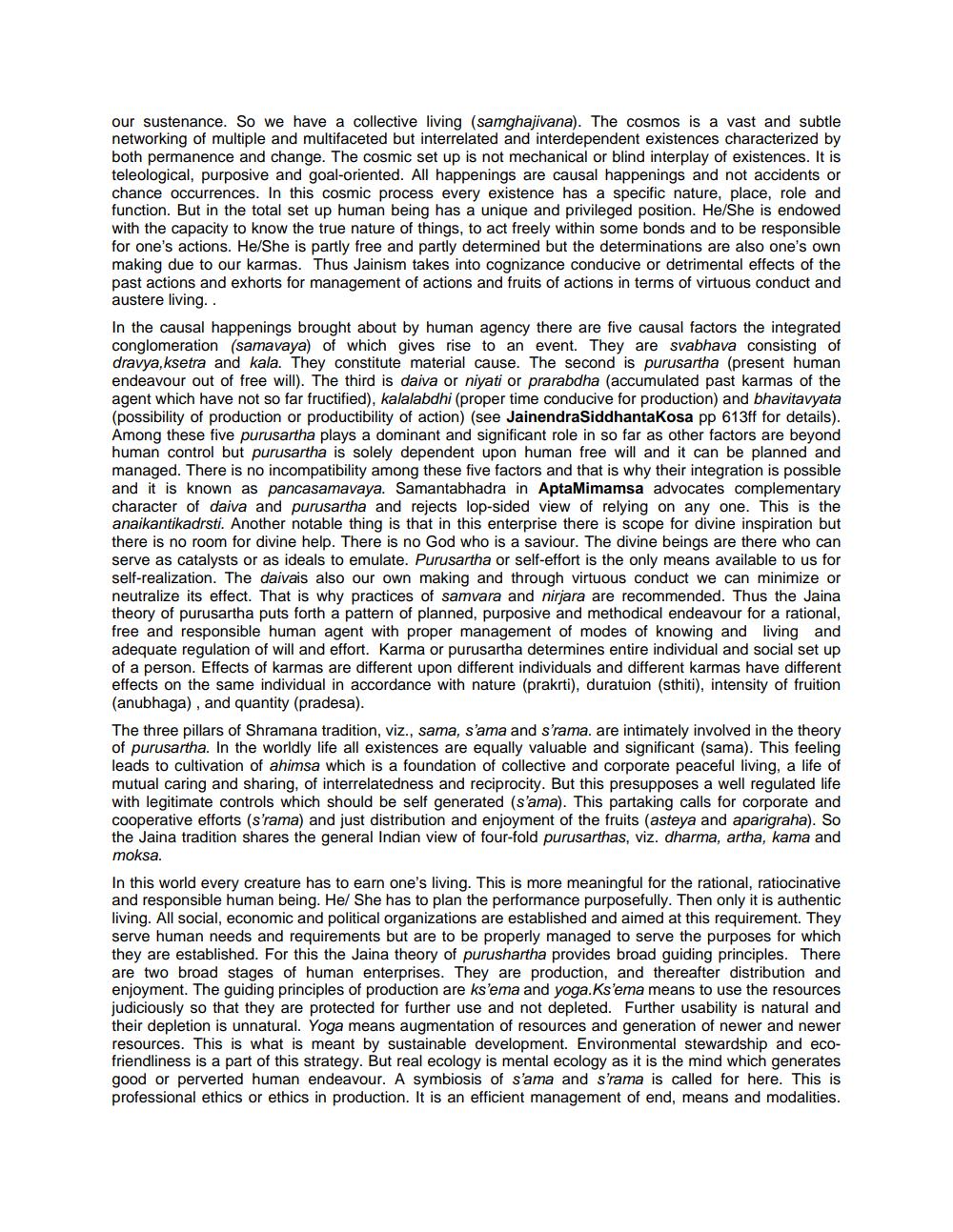________________
our sustenance. So we have a collective living (samghajivana). The cosmos is a vast and subtle networking of multiple and multifaceted but interrelated and interdependent existences characterized by both permanence and change. The cosmic set up is not mechanical or blind interplay of existences. It is teleological, purposive and goal-oriented. All happenings are causal happenings and not accidents or chance occurrences. In this cosmic process every existence has a specific nature, place, role and function. But in the total set up human being has a unique and privileged position. He/She is endowed with the capacity to know the true nature of things, to act freely within some bonds and to be responsible for one's actions. He/She is partly free and partly determined but the determinations are also one's own making due to our karmas. Thus Jainism takes into cognizance conducive or detrimental effects of the past actions and exhorts for management of actions and fruits of actions in terms of virtuous conduct and austere living..
In the causal happenings brought about by human agency there are five causal factors the integrated conglomeration (samavaya) of which gives rise to an event. They are svabhava consisting of dravya,ksetra and kala. They constitute material cause. The second is purusartha (present human endeavour out of free will). The third is daiva or niyati or prarabdha (accumulated past karmas of the agent which have not so far fructified), kalalabdhi (proper time conducive for production) and bhavitavyata (possibility of production or productibility of action) (see JainendraSiddhantaKosa pp 613ff for details). Among these five purusartha plays a dominant and significant role in so far as other factors are beyond human control but purusartha is solely dependent upon human free will and it can be planned and managed. There is no incompatibility among these five factors and that is why their integration is possible and it is known as pancasamavaya. Samantabhadra in AptaMimamsa advocates complementary character of daiva and purusartha and rejects lop-sided view of relying on any one. This is the anaikantikadrsti. Another notable thing is that in this enterprise there is scope for divine inspiration but there is no room for divine help. There is no God who is a saviour. The divine beings are there who can serve as catalysts or as ideals to emulate. Purusartha or self-effort is the only means available to us for self-realization. The daivais also our own making and through virtuous conduct we can minimize or neutralize its effect. That is why practices of samvara and nirjara are recommended. Thus the Jaina theory of purusartha puts forth a pattern of planned, purposive and methodical endeavour for a rational, free and responsible human agent with proper management of modes of knowing and living and adequate regulation of will and effort. Karma or purusartha determines entire individual and social set up of a person. Effects of karmas are different upon different individuals and different karmas have different effects on the same individual in accordance with nature (prakrti), duratuion (sthiti), intensity of fruition (anubhaga), and quantity (pradesa).
The three pillars of Shramana tradition, viz., sama, s'ama and s'rama. are intimately involved in the theory of purusartha. In the worldly life all existences are equally valuable and significant (sama). This feeling leads to cultivation of ahimsa which is a foundation of collective and corporate peaceful living, a life of mutual caring and sharing, of interrelatedness and reciprocity. But this presupposes a well regulated life with legitimate controls which should be self generated (s'ama). This partaking calls for corporate and cooperative efforts (s'rama) and just distribution and enjoyment of the fruits (asteya and aparigraha). So the Jaina tradition shares the general Indian view of four-fold purusarthas, viz. dharma, artha, kama and moksa.
In this world every creature has to earn one's living. This is more meaningful for the rational, ratiocinative and responsible human being. He/ She has to plan the performance purposefully. Then only it is authentic living. All social, economic and political organizations are established and aimed at this requirement. They serve human needs and requirements but are to be properly managed to serve the purposes for which they are established. For this the Jaina theory of purushartha provides broad guiding principles. There are two broad stages of human enterprises. They are production, and thereafter distribution and enjoyment. The guiding principles of production are ks'ema and yoga. Ks'ema means to use the resources judiciously so that they are protected for further use and not depleted. Further usability is natural and their depletion is unnatural. Yoga means augmentation of resources and generation of newer and newer resources. This is what is meant by sustainable development. Environmental stewardship and ecofriendliness is a part of this strategy. But real ecology is mental ecology as it is the mind which generates good or perverted human endeavour. A symbiosis of s'ama and s'rama is called for here. This is professional ethics or ethics in production. It is an efficient management of end, means and modalities.




